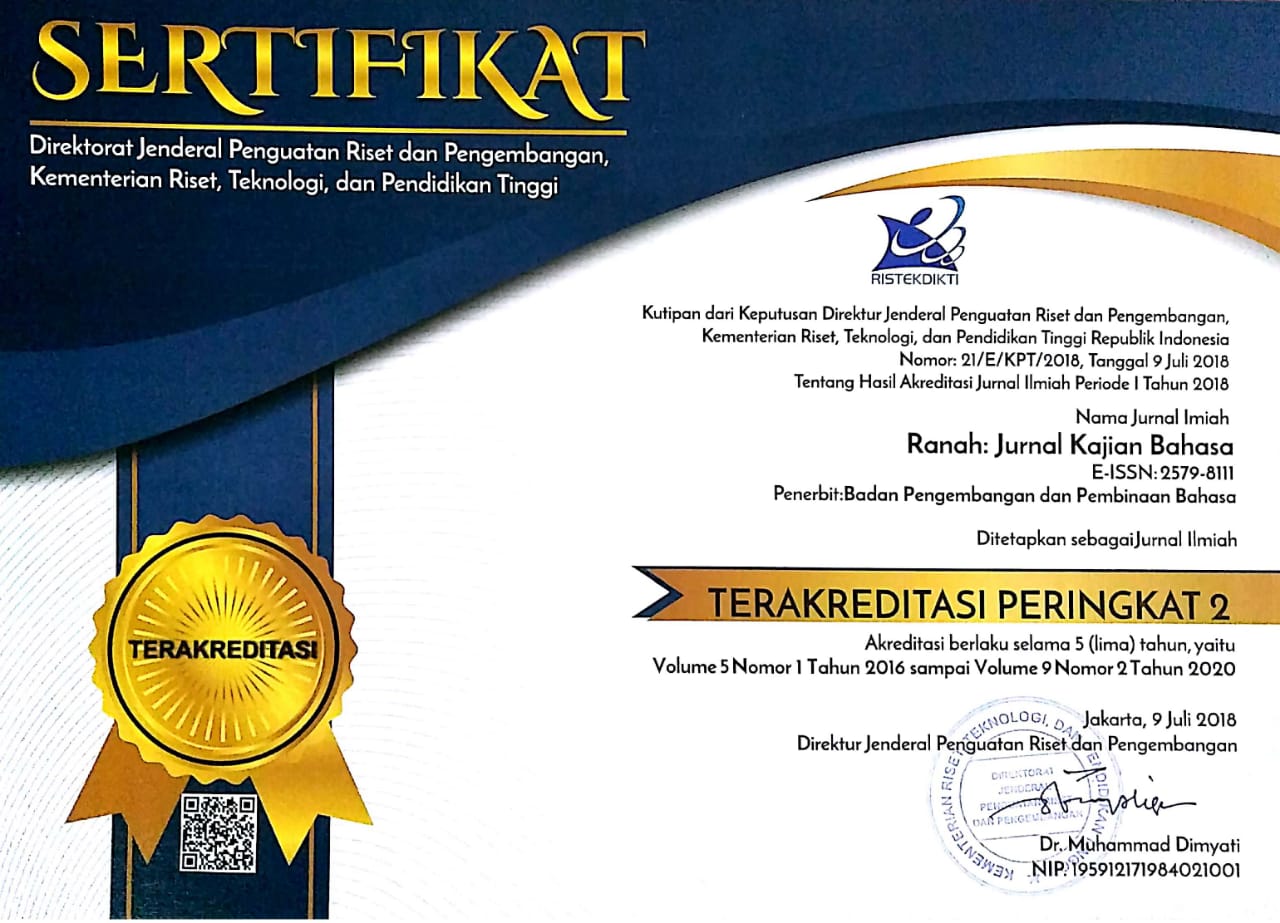Critical Discourse Analysis of Pantun in Elementary School Textbook
Abstract
The purpose of this study is to explain the use of pantun in textbooks in elementary schools, especially the description of the use of types of rhymes, errors in the number of syllables, distribution of pantun types based on age/user, distribution of pantun types based on content, distribution of thematic pantun, pantun distribution based on integrativeness, distribution pantun based on cross-curriculum integration. This research is classified as Critical Discourse Analysis which is part of qualitative research so it uses actual, objective, and systematic explanations. The research was conducted by analyzing and interpreting the pantun contained in the text of elementary school textbooks, both those used by teachers and books used by students. Critical discourse analysis is seen from the perspective of the author. This research provides a more concrete picture of the involvement of textbooks in the preservation of pantun as an Indonesian cultural heritage. In this study, positive results were shown, the existence of pantun in textbooks had created expressive spaces for students.
Abstrak
Tujuan penelitian ini untuk menjelaskan penggunaan pantun dalam buku pelajaran di sekolah dasar khususnya uraian penggunaan jenis rima, penggunaan jumlah suku kata, pembagian jenis pantun berdasarkan usia/pengguna, pembagian jenis pantun berdasarkan isi, pembagian pantun tematik, pembagian pantun berdasarkan keterpaduan, pembagian pantun berdasarkan integrasi lintas kurikulum. Penelitian ini tergolong dalam penelitian Analisis Wacana Kritis yang merupakan bagian dari penelitian kualitatif sehingga menggunakan penjelasan yang aktual, objektif, dan sistematis. Penelitian dilakukan dengan menganalisis dan menginterpretasikan pantun yang terdapat dalam teks buku pelajaran sekolah dasar, baik yang digunakan oleh guru maupun buku yang digunakan oleh siswa. Analisis wacana kritis dilihat dari sudut pandang pengarang. Penelitian ini memberikan gambaran yang lebih konkret tentang keterlibatan buku ajar dalam pelestarian pantun sebagai warisan budaya Indonesia. Dalam penelitian ini ditunjukkan hasil yang positif, keberadaan pantun dalam buku pelajaran telah menciptakan ruang ekspresif bagi siswa.
Keywords
Full Text:
PDFReferences
Andari, I. T., & Suharto, S. (2020). The Function of Pantun in the Art Performace of Batang Hari Sembilan Solo Guitar during Sedekah Bumi Ceremony Held in Batu Urip Hamlet, South Sumatera. Harmonia: Journal of Arts Research and Education, 20(2), 195-204. https://doi.org/10.15294/harmonia.v20i2.28057
https://doi.org/10.15294/harmonia.v20i2.28057
Astuti, I. M. J., Kristianti, W., & Adhalia, D. (2016). Bupena: Buku Penilaian Tema Sehat Itu Penting dan Ekosistem Jilid 5B untuk SD/MI Kelas V Berdasarkan Kurikulum 2013 Revisi. Erlangga.
Effendy, T. (2005). Pantun Nasehat (M. Al Mudra (ed.)). Adicita Karya.
Elo, S., Kääriäinen, M., Kanste, O., Pölkki, T., Utriainen, K., & Kyngäs, H. (2014). Qualitative Content Analysis. SAGE Open, 4(1), 215824401452263. https://doi.org/10.1177/2158244014522633
Emelia, T. W. (2015). Model Revitalisasi Kearifan Lokal Dalam Tradisi Lisan Berpantun Masyarakat Melayu Labuhan Batu Sumatera Utara. In Laporan Akhir Penelitian Disertasi Doktor (Issue 005). http://publikasiilmiah.umsu.ac.id/index.php/publikasi-ilmiah/article/view/44%0Ahttp://publikasiilmiah.umsu.ac.id/index.php/publikasi-ilmiah/article/viewFile/44/36
Fairclough, N. (2001). Critical discourse analysis as a method in social scientific research. In R. Wodak & M. Meyer (Eds.), Methods of Critical Discourse Analysis (pp. 121-138). SAGE Publications.
https://doi.org/10.4135/9780857028020.n6
Fang, L. Y. (2016). Sejarah Kesusastraan Melayu Klasik. Yayasan Obor Indonesia.
Furenes, M. I., & Bus, A. G. (2021). A Comparison of Children ' s Reading on Paper Versus Screen : A Meta-Analysis (Vol. 91, Issue 4). https://doi.org/10.3102/0034654321998074
Furman, R. (2020). The tenderness and vulnerability of older expatriate men: a poetic inquiry of research and autoethnographic poems. Journal of Poetry Therapy, 33(1), 44-49. https://doi.org/10.1080/08893675.2020.1694222
Hanson, K. (2003). Formal Variation in the Rhymes of Robert Pinsky's the Inferno of Dante. Language and Literature: International Journal of Stylistics, 12(4), 309-337. https://doi.org/10.1177/09639470030124002
Harun, M. (2015). Karakteristik Pantun Aceh. Lingua: Journal of Language, Literature and Teaching, 12(1), 39-58. https://doi.org/10.30957/lingua.v12i1.70
Karpouza, E., Zampanioti, A., & Karakitsios, A. (2014). Children's books in education: Teacher's and Students' Selection Criteria. International Annual Conference The Child and the Book Conference "Time, Space, and Memory in Literature for Children and Young Adults," 1-9.
Marhalim, Z. (2018). Mengenal Tunjuk Ajar Melayu dalam Pantun, Gurindam, dan Syair. Badan Pengembangan dan Pembinaan Bahasa.
Mat, P., Huslinda, N., Mat, C., & Sukor, N. (2012). Using Pantuns in Greetings as A Tool to Promote Learners ' U se of Metacognitive Strategies in Online ESL Learning. Procedia - Social and Behavioral Sciences, 67(November 2011), 500-512. https://doi.org/10.1016/j.sbspro.2012.11.355
Maulina, D. E. (2015). Keanekaragaman Pantun Di Indonesia. Semantik, 1(1), 107-121. https://doi.org/https://doi.org/10.22460/semantik.v1i1.p%25p
Maynard, S., Davies, J. E., & Robinson, R. (2005). Poetry for pleasure. Journal of Librarianship and Information Science, 37(1), 35-43. https://doi.org/10.1177/0961000605052158
Moss, B. (2008). The information text gap: The mismatch between non-narrative text types in basal readers and 2009 NAEP recommended guidelines. Journal of Literacy Research, 40(2), 201-219. https://doi.org/10.1080/10862960802411927
Murdianto, M. (2020). Khazanah Folklor untuk Menumbuhkan Karakter Empati dan Cinta Kasih. Aphorisme: Journal of Arabic Language, Literature, and Education, 1(2), 92-104. https://doi.org/10.37680/aphorisme.v1i2.474
Pulimeno, M., Piscitelli, P., & Colazzo, S. (2020). Children's literature to promote students' global development and wellbeing. Health Promotion Perspectives, 10(1), 13-23. https://doi.org/10.15171/hpp.2020.05
Rofam, G. N. K. M., Zazin, N., Batubara, H. H., & Arini, D. N. (2018). Thematic Learning Model on Lower Class Student in SDIT Ukhuwah Banjarmasin. Proceedings of the Borneo International Conference on Education and Social Sciences, Bicess 2018, 337-346. https://doi.org/10.5220/0009020803370346
Salleh, M. H. (2011). Sailing the Archipelago in a boat of rhymes Pantun in the Malay world. Wacana, Journal of the Humanities of Indonesia, 13(1), 78. https://doi.org/10.17510/wjhi.v13i1.10
https://doi.org/10.17510/wjhi.v13i1.10
Schiffrin, D., Tannen, D., & Hamilton, H. E. (2007). The Handbook of Discourse Analysis. The Handbook of Discourse Analysis, 568-589. https://doi.org/10.1111/b.9780631205968.2003.00030.x
Solihati, N., & Hikmat, A. (2018). Critical Thinking Tasks Manifested in Indonesian Language Textbooks for Senior Secondary Students. SAGE Open, 8(3), 2158244018802164. https://doi.org/10.1177/2158244018802164
Subekti, A. (2017a). Tematik Terpadu Kurikulum 2013 untuk Guru SD/MI Kelas V. Pusat Kurikulum dan Perbukuan, Balitbang, Kemendikbud.
Subekti, A. (2017b). Tematik Terpadu Kurikulum 2013 untuk Siswa SD/MI Kelas V. Pusat Kurikulum dan Perbukuan, Balitbang, Kemendikbud.
DOI: https://doi.org/10.26499/jentera.v11i2.5666
Refbacks
- There are currently no refbacks.






















